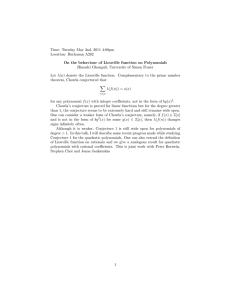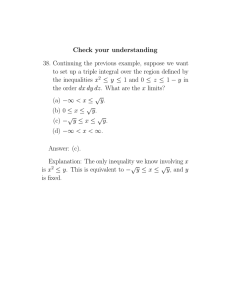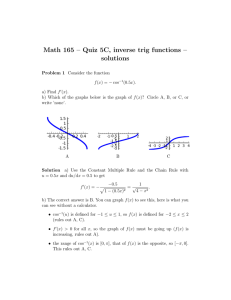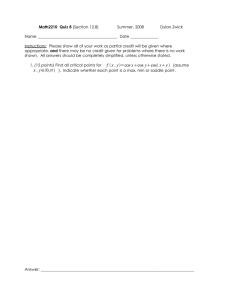View PDF - CiteSeerX
advertisement
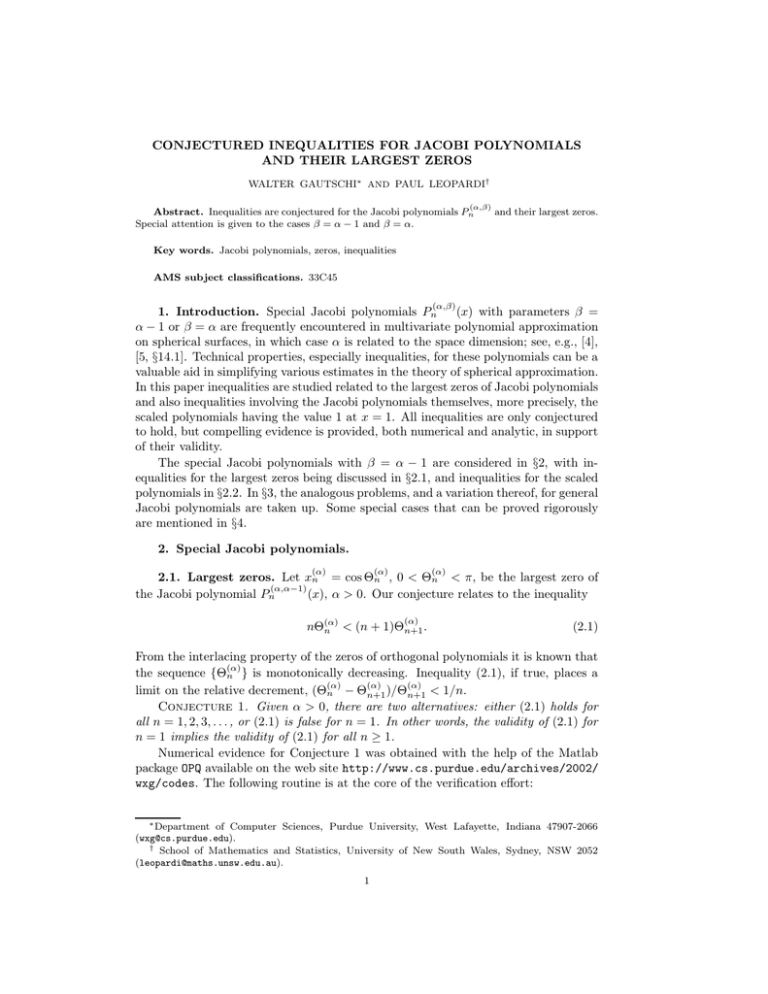
CONJECTURED INEQUALITIES FOR JACOBI POLYNOMIALS
AND THEIR LARGEST ZEROS
WALTER GAUTSCHI∗ AND PAUL LEOPARDI†
(α,β)
Abstract. Inequalities are conjectured for the Jacobi polynomials Pn
Special attention is given to the cases β = α − 1 and β = α.
and their largest zeros.
Key words. Jacobi polynomials, zeros, inequalities
AMS subject classifications. 33C45
(α,β)
1. Introduction. Special Jacobi polynomials Pn
(x) with parameters β =
α − 1 or β = α are frequently encountered in multivariate polynomial approximation
on spherical surfaces, in which case α is related to the space dimension; see, e.g., [4],
[5, §14.1]. Technical properties, especially inequalities, for these polynomials can be a
valuable aid in simplifying various estimates in the theory of spherical approximation.
In this paper inequalities are studied related to the largest zeros of Jacobi polynomials
and also inequalities involving the Jacobi polynomials themselves, more precisely, the
scaled polynomials having the value 1 at x = 1. All inequalities are only conjectured
to hold, but compelling evidence is provided, both numerical and analytic, in support
of their validity.
The special Jacobi polynomials with β = α − 1 are considered in §2, with inequalities for the largest zeros being discussed in §2.1, and inequalities for the scaled
polynomials in §2.2. In §3, the analogous problems, and a variation thereof, for general
Jacobi polynomials are taken up. Some special cases that can be proved rigorously
are mentioned in §4.
2. Special Jacobi polynomials.
(α)
(α)
(α)
2.1. Largest zeros. Let xn = cos Θn , 0 < Θn < π, be the largest zero of
(α,α−1)
the Jacobi polynomial Pn
(x), α > 0. Our conjecture relates to the inequality
(α)
nΘ(α)
n < (n + 1)Θn+1 .
(2.1)
From the interlacing property of the zeros of orthogonal polynomials it is known that
(α)
the sequence {Θn } is monotonically decreasing. Inequality (2.1), if true, places a
(α)
(α)
(α)
limit on the relative decrement, (Θn − Θn+1 )/Θn+1 < 1/n.
Conjecture 1. Given α > 0, there are two alternatives: either (2.1) holds for
all n = 1, 2, 3, . . . , or (2.1) is false for n = 1. In other words, the validity of (2.1) for
n = 1 implies the validity of (2.1) for all n ≥ 1.
Numerical evidence for Conjecture 1 was obtained with the help of the Matlab
package OPQ available on the web site http://www.cs.purdue.edu/archives/2002/
wxg/codes. The following routine is at the core of the verification effort:
∗ Department of Computer Sciences, Purdue University, West Lafayette, Indiana 47907-2066
(wxg@cs.purdue.edu).
† School of Mathematics and Statistics, University of New South Wales, Sydney, NSW 2052
(leopardi@maths.unsw.edu.au).
1
2
WALTER GAUTSCHI AND PAUL LEOPARDI
ab=r jacobi(n+1,a,a-1);
for k=1:n
xw=gauss(k,ab); xw1=gauss(k+1,ab);
theta=acos(xw(k,1)); theta1=acos(xw1(k+1,1));
if k*theta >= (k+1)*theta1
[k*theta,(k+1)*theta1], a, k, error(’conjecture 1 false’)
end
end
The first command generates the recursion coefficients for the special Jacobi polynomials, which are used in the routine gauss to compute the nodes and weights of the
respective Gaussian quadrature rules. Only the nodes, stored (in increasing order) in
the first column of the array xw resp. xw1 are of interest here.
When the verification routine is run with n = 100 and a = [0.5 : 0.01 : 1, 1.1 :
0.1 : 10, 10.5 : 0.5 : 20], the error statement is never invoked. On the other hand,
when a = 0.5 : −0.01 : 0.01, the error message appears with a = 0.13, n = 1, and
likewise, when a = 0.14 : −0.0001 : 0.13, it appears with a = 0.1350, n = 1. It thus
appears that Conjecture 1 is true, and that inequality (2.1) holds for all n ≥ 1 and
for all α > α0 , where 0.1350 < α0 < 0.1351. In order to determine α0 more precisely,
we examine the case n = 1.
From the recurrence relation for Jacobi polynomials (see, e.g., [7, eqn (4.5.1)])
one finds
(α,α−1)
P1
(α,α−1)
4P2
Therefore,
(α)
x1
(x) =
1
2
((2α + 1)x + 1) ,
(x) = (α + 1) (2α + 3)x2 + 2x − 1 .
=−
1
,
2α + 1
(α)
x2
=
1
√
,
1 + 2α + 4
(2.2)
(2.3)
and (2.1) for n = 1 is equivalent to
1
1
√
< 2 arccos
arccos −
,
2α + 1
1 + 2α + 4
or, using arccos(−t) = π − arccos(t), equivalent to
2 arccos
1+
1
1
√
− π > 0.
+ arccos
2α + 1
2α + 4
(2.4)
The left-hand side is a strictly increasing function of α, negative for α = 0 and tending
to 21 π as α → ∞. Therefore, if α0 is the unique root of
2 arccos
1
1
√
− π = 0,
+ arccos
2α + 1
1 + 2α + 4
(2.5)
then (2.4), and hence (2.1) for n = 1, holds exactly if α > α0 . Using the Matlab
routine fzero, one finds
α0 = 0.13507978085964.
Thus, if Conjecture 1 is true, then (2.1) holds for all n ≥ 1 precisely if α > α 0 .
(2.6)
3
INEQUALITIES FOR JACOBI POLYNOMIALS AND THEIR ZEROS
2.2. Scaled polynomials. For the remainder of this paper, we use the abbreviated notation
(α,β)
Pn
(x)
.
Pen(α,β) (x) := (α,β)
Pn
(1)
(2.7)
The conjecture for the Jacobi polynomials themselves involves the inequality
θ
θ
(α,α−1)
(α,α−1)
e
e
Pn
cos
cos
< Pn+1
.
(2.8)
n
n+1
With notation as in §2.1 we consider two intervals for θ,
(α)
0 < θ < Θ1 ,
and 0 < θ < π,
(2.9)
where
(α)
cos Θ1
(α)
= x1
=−
1
.
2α + 1
(2.10)
Conjecture 2. Given α > 0, there are two alternatives for each of the two
intervals (2.9): either (2.8) holds for all n = 1, 2, 3, . . . and all θ in the respective
interval, or (2.8) is false for n = 1 and some θ in the respective interval. In other
words, the validity of (2.8) for n = 1 implies the validity of (2.8) for all n ≥ 1.
The verification routine for Conjecture 2 is a bit more intricate than the one for
Conjecture 1. Its core is shown below.
ab=r jacobi(n+1,a,a-1);
th1=acos(-1/(2*a+1));
% th1=pi;
for nu=1:N
th=nu*th1/(N+1);
for k=1:n
x0=1; x=cos(th/k); y=cos(th/(k+1));
p0=0; p01=1; px=0; px1=1; py=0; py1=1;
for r=1:k+1
p0m1=p0; p0=p01; pxm1=px; px=px1; pym1=py; py=py1;
p01=(x0-ab(r,1))*p0-ab(r,2)*p0m1;
px1=(x-ab(r,1))*px-ab(r,2)*pxm1;
py1=(y-ab(r,1))*py-ab(r,2)*pym1;
end
if px/p0 >= py1/p01
[px/p0,py1/p01], a, k, nu, error(’conjecture 2 false’)
end
end
end
Run with n = 100, N = 1000, and a as in §2.1, the routine for the first interval of
(2.9) produces the same results as in §2.1, provided N is increased to N = 5000 for the
last set of a-values. Conjecture 2 thus appears to be true, and inequality (2.8) valid
(α)
for 0 < θ < Θ1 precisely if α > α0 . In the case of the second interval 0 < θ < π, the
first set of a-values, when N = 1000, again produces no error message, the second set,
with N = 5000, an error message with a = 0.28, n = 1, and a = 0.29 : −0.001 : 0.28
4
WALTER GAUTSCHI AND PAUL LEOPARDI
an error message with a = 0.280, n = 1. Inequality (2.8) for the second interval thus
seems to hold if α > α1 , where 0.280 < α1 < 0.290.
To get more precise information, we analyze the case n = 1, i.e.,
θ
(α,α−1)
(α,α−1)
e
e
.
(2.11)
cos
P1
(cos θ) < P2
2
From (2.2), we have
(2α + 1) cos θ + 1
(α,α−1)
Pe1
(cos θ) =
,
2(α + 1)
(2α + 3) cos2 θ2 + 2 cos θ2 − 1
θ
(α,α−1)
,
Pe2
=
cos
2
2(α + 2)
so that (2.11), using cos θ = 2 cos2
θ
2
(2.12)
− 1, becomes
θ
θ
− 2(1 + α) cos + (1 − 3α − 2α2 ) < 0,
2
2
(1 + 5α + 2α2 ) cos2
or, simplifying,
(u − 1)[(1 + 5α + 2α2 )u − (1 − 3α − 2α2 )] < 0,
u := cos
θ
.
2
Since u − 1 < 0 on either interval (2.9), this is the same as
(1 + 5α + 2α2 )u − (1 − 3α − 2α2 ) > 0,
or, since 1 + 5α + 2α2 > 0,
u>
1 − 3α − 2α2
,
1 + 5α + 2α2
u := cos
θ
.
2
(2.13)
(α)
Consider first the interval 0 < θ < Θ1 . Then (2.13) holds precisely if
s
r
(α)
(α)
Θ1
1 + cos Θ1
α
1 − 3α − 2α2
cos
=
=
>
.
2
2
2α + 1
1 + 5α + 2α2
(2.14)
Using the Matlab routine fzero, one finds
α > α0 ,
(2.15)
where, interestingly, α0 is exactly the same as in (2.6).
On the second interval 0 < θ < π, we have (2.13) precisely if
cos
1 − 3α − 2α2
π
=0>
,
2
1 + 5α + 2α2
i.e., if
α > α1 =
1
4
√
( 17 − 3) = .28077640640442.
(2.16)
In summary, if Conjecture 2 is true, then the inequality (2.8) holds for all n ≥ 1 on the
first interval (2.9) precisely if α > α0 , and on the second interval precisely if α > α1 ,
where α0 , α1 are given by (2.6) and (2.16), respectively.
5
INEQUALITIES FOR JACOBI POLYNOMIALS AND THEIR ZEROS
We remark that by squaring (2.14) and removing the root α = −1, one finds that
α0 is the smallest positive root of the quartic equation
4α4 + 4α3 − 11α2 − 6α + 1 = 0.
(2.17)
The same equation can be obtained from (2.5), written in the form
1
1
√
.
= arccos −
2 arccos
2α + 1
1 + 2α + 4
(2.18)
Indeed, observing that 2 arccos t = arccos(2t2 − 1), eqn (2.18) implies
(1 +
√
2
1
−1=−
,
2
2α + 1
2α + 4)
or
α(1 +
√
2α + 4)2 = 2α + 1.
By an elementary calculation, this yields (2.17).
3. General Jacobi polynomials.
(α,β)
(α,β)
(α,β)
3.1. Largest zeros. We now denote by xn
= cos Θn , 0 < Θn
< π, the
(α,β)
largest zero of the Jacobi polynomial Pn
(x), α > −1, β > −1. We consider the
inequality analogous to (2.1),
(α,β)
nΘ(α,β)
< (n + 1)Θn+1 .
n
(3.1)
The case α = β = −1/2 of Chebyshev polynomials is exceptional here, since Θ n =
π/2n, and both sides of (3.1) are identically equal to π/2.
Using an obvious extension of the Matlab routine in §2.1, we are led to conjecture:
Conjecture 3. Given α > −1, β > −1, there are two alternatives: either (3.1)
holds for all n = 1, 2, 3, . . . , or (3.1) is false for n = 1. In other words, the validity of
(3.1) for n = 1 implies the validity of (3.1) for all n ≥ 1.
It is known that
(α)
lim nΘ(α,β)
= j1 ,
n
(3.2)
n→∞
(α)
where j1 is the first positive zero of the Bessel function Jα (cf. [7, Theorem 8.1.2]).
Conjecture 3, if true, then states that the validity of (3.1) for n = 1 implies that
convergence in (3.2) is monotone increasing.
The following is our evidence for Conjecture 3. Running the (extended) verification routine of §2.1 with n up to 100, and for each α = 1.01 : 0.01 : 1.2, 1.3 : 0.1 : 5.0, 6 :
1 : 20 for β = −0.99 : 0.01 : −0.80, −0.7 : 0.1 : 0.0, 1 : 1 : 20, no error message was encountered, suggesting that the inequality (3.1) holds for all n ≥ 1 in the infinite domain
α > 1, β > −1. When one takes α = 0.9 : −0.1 : −0.9, however, and for each of these
α goes through β = 20 : −1 : 0, −0.1 : −0.1 : −0.9, −0.89 : −0.01 : −0.99, −0.999,
then an error message appears, always with n = 1, for the following pairs of values
(α, β):
α
β
0.9
–0.999
α
β
0.8
–0.999
–0.1
–0.8
0.7
–0.99
–0.2
–0.8
–0.3
–0.7
0.6
–0.98
–0.4
–0.6
0.5
–0.97
–0.5
–0.5
0.4
–0.95
–0.6
–0.5
0.3
–0.92
–0.7
–0.4
0.2
–0.90
–0.8
–0.3
0.1
–0.9
–0.9
–0.2
0
–0.9
6
WALTER GAUTSCHI AND PAUL LEOPARDI
The results suggest that in the strip −1 < α < 1, β > −1, there exists a curve, monotonically decreasing from 0 to −1, above which (3.1) holds for all n ≥ 1, and below
which inequality (3.1) fails for n = 1. We will compute this curve more accurately
when, as we now begin to do, the case n = 1 is examined.
In analogy to (2.2), we find
(α,β)
P1
(α,β)
8P2
(x) =
1
2
((α + β + 2)x + α − β) ,
(x) = (α + β + 3)(α + β + 4)x2 + 2(α + β + 3)(α − β)x
(3.3)
+(α − β)2 − (α + β + 4),
from which
(α,β)
x1
(α,β)
x2
α−β
,
α + β + 2"
s
#
αβ − 2
1
−(α − β) + 2 2 +
.
=
α+β+4
α+β+3
=−
Inequality (3.1), therefore, analogously to (2.5), can be given the form
s
"
#!
αβ − 2
1
−(α − β) + 2 2 +
2 arccos
α+β+4
α+β+3
(3.4)
(3.5)
α−β
− π > 0.
+ arccos
α+β+2
When α = β = − 21 , this gives 2 π4 + π2 − π = 0, i.e., equality in (3.1), as was already
noted above. The same is true for α = 1 and β → −1, and for α > 1 and β → ∞.
When α > 1 is fixed, and β increases from −1 to ∞, the graph of (3.5) sharply
increases from a positive value to a maximum and then decreases monotonically to
zero, so that (3.5) holds for all α > 1, β > −1, in agreement with what was found
numerically above.
When −1 < α < 1 is fixed, the equation in β resulting from replacing inequality
in (3.5) by equality, can be solved numerically by the Matlab routine fzero. This
produces the curve shown in Fig 1. Inequality (3.1) for n = 1 thus holds in the region
0
−0.1
−0.2
−0.3
−0.4
−0.5
−0.6
−0.7
−0.8
−0.9
−1
−1
−0.8
−0.6
−0.4
−0.2
0
0.2
0.4
0.6
0.8
1
Figure 1. The boundary curve of the domain of validity for (3.1)
above this curve, and, together with (−1 < α < 1, β > 0) ∪ (1 < α < ∞, β > −1),
this is the region of validity of the inequality for all n ≥ 1 if Conjecture 3 is true.
INEQUALITIES FOR JACOBI POLYNOMIALS AND THEIR ZEROS
7
The graph also sheds new light on the result found in §2.1: If the inequality is to
be true for (α, β = α − 1), then the point of intersection of the line β = α − 1 with the
boundary curve of Fig. 1 determines α0 . Setting β = α − 1 in (3.5) and replacing the
inequality sign with the equality sign indeed yields (2.5). Similarly, if β = α, the point
of intersection of the line β = α with the curve yields α = − 21 , as is easily verified.
Inequality (3.5) thus holds for β = α > − 21 , and therefore, if Conjecture 3 is true,
inequality (3.1) in the ultraspherical case β = α holds for all α > − 21 . It is actually
known to hold for − 21 < α < 21 in the sharper form (n + α + 12 )Θn < (n + α + 23 )Θn+1 ;
cf. [7, §6.3(5), p. 127]. However, this sharper inequality ceases to hold when α ≥ 21 .
3.2. Scaled polynomials. The inequality to be studied here is
θ
θ
(α,β)
Pen(α,β) cos
< Pen+1 cos
,
n
n+1
with Pe defined by (2.7), on either of the two intervals
(α,β)
0 < θ < Θ1
,
0 < θ < π,
(3.6)
(3.7)
where
(α,β)
cos Θ1
(α,β)
= x1
=−
α−β
.
α+β+2
(3.8)
We note again the exceptional case α = β = −1/2, in which both sides of (3.6) are
identically equal to cos θ.
Conjecture 4. Given α > −1, β > −1, there are two alternatives for each
of the two intervals (3.7): either (3.6) holds for all n = 1, 2, 3, . . . and all θ in the
respective interval, or (3.6) is false for n = 1 and some θ in the respective interval. In
other words, the validity of (3.6) for n = 1 implies the validity of (3.6) for all n ≥ 1.
Since
n+α
nα
(α,β)
Pn
(1) =
∼
as n → ∞,
n
Γ(α + 1)
the result in [7, Theorem 8.1.1] can be rephrased in the form
−α
θ
θ
(α,β)
e
lim P
cos
Jα (θ),
= Γ(α + 1)
n→∞ n
n
2
(3.9)
where Jα is the Bessel function of order α. Therefore, Conjecture 4, if true, states
that the validity of (3.6) for n = 1 implies that convergence in (3.9) is monotone
increasing.
The Matlab script of §2.2 is easily adapted to deal with the conjecture (3.6) for
general Jacobi polynomials. When run with the same data as used to verify Conjecture
3, with n = 100 and N = 1000, similar results were obtained as in §3.1, i.e., a strong
indication that (3.6) holds on either interval (3.7) for all n ≥ 1 whenever α > 1 and
β > −1, while for α in the interval (−1, 1) the same is true for β above a certain curve
that extends from the point (α, β) = (−1, 0) down to the point (α, β) = (1, −1). For
β below that curve, the conjecture fails consistently when n = 1. As will be seen, the
initial part of this curve, for −1 < α < − 21 , is the straight line β = −α − 1.
This all will become more clear by analyzing (3.6) in the case n = 1,
θ
(α,β)
(α,β)
e
e
P1
(cos θ) < P2
.
(3.10)
cos
2
8
WALTER GAUTSCHI AND PAUL LEOPARDI
From (3.3) we first note that
(α + β + 2) cos θ + α − β
(α,β)
Pe1
(cos θ) =
2(α + 1)
and
where
N (α, θ)
θ
(α,β)
e
=
cos
,
P2
2
4(α + 1)(α + 2)
N (α, θ) = (α+β +3)(α+β +4) cos2
θ
θ
+2(α+β +3)(α−β) cos +(α−β)2 −(α+β +4).
2
2
The inequality (3.10) then becomes, after simplification,
(u − 1)[(3α2 + 2αβ + 9α − β 2 + β + 4)u + α2 + 2αβ + β 2 + 3α + 7β + 4] < 0,
with u as in (2.13). Again, since u − 1 < 0 on either of the two intervals (3.7), the
inequality to be studied is
(3α2 + 2αβ + 9α − β 2 + β + 4)u + α2 + 2αβ + β 2 + 3α + 7β + 4 > 0,
u := cos θ2 .
(3.11)
Lemma 3.1. Let a, b be real numbers, and consider the inequality
au + b > 0
on u0 < u < 1, u0 ≥ 0.
(3.12)
If a + b ≥ 0, then (3.12) is always true except when a = b = 0 or a > 0, b < 0, and
u0 < −b/a. If a + b < 0, then (3.12) is never true.
Proof. Immediate on geometric grounds.
We now apply Lemma 3.1 to (3.11), i.e., to
a = 3α2 + 2αβ + 9α − β 2 + β + 4,
b = α2 + 2αβ + β 2 + 3α + 7β + 4.
(3.13)
Here, one computes
a + b = 4(α + 2)(α + β + 1).
Since α + 2 > 0, inequality (3.11) is false on either of the two intervals (3.7) if
α + β + 1 < 0. In the case α + β + 1 ≥ 0 it is false if a = b = 0, which implies
α = β = − 21 , or if
a > 0, b < 0, and u0 < −b/a,
(3.14)
with a, b as defined in (3.13). The curve b = 0 is given by
√
β = −α − 27 + 21 16α + 33, −1 < α < 1.
By plotting the respective curves in the (α, β)-plane, one finds that b < 0 combined
with α + β + 1 ≥ 0 and β ≥ −1, cuts out the domain D shown in Fig. 2. Inequality
(3.11) thus holds for all (α, β) located above the upper boundary curve of D and to
INEQUALITIES FOR JACOBI POLYNOMIALS AND THEIR ZEROS
9
0.2
0
−0.2
−0.4
−0.6
b=0
−0.8
D
−1
α+β+1=0
a=0
−1
−0.8
−0.6
−0.4
−0.2
0
0.2
0.4
0.6
0.8
1
Figure 2. The boundary curves for the domain of validity of (3.10)
the right of the line α + β + 1 = 0, and for those (α, β) in the interior of D precisely
if u0 > −b/a in (3.14). On the first interval (3.7), this will be true precisely if
s
s
(α,β)
(α,β)
Θ1
1 + cos Θ1
β+1
=
=
u0 = cos
2
2
α+β+2
(3.15)
α2 + 2αβ + β 2 + 3α + 7β + 4
>− 2
.
3α + 2αβ + 9α − β 2 + β + 4
This is the curve plotted inside the domain D of Fig. 2, above which inequality
(3.11) is true, and below which it is false. This, together with the discussion above,
completely delineates the domain of validity of (3.10) on the first interval (3.7). On
the second interval we have u0 = cos π2 = 0, and the third inequality in (3.14) is a
consequence of the other two. Thus, (3.10) is false in all of D, and the domain of
validity of (3.10) is the region above the upper boundary of D, to the right of the line
α + β + 1 = 0, and of course bounded by the lines α = −1 and β = −1. If Conjecture
4 is true, the same domains of validity hold for the inequality (3.6).
We remark that the special case β = α − 1, α > 0, turns (3.15) into (2.14), and
the inequality b > 0 into (2.16). Likewise, the line β = α, α > −1, passes through the
point (− 21 , − 21 ) where all the curves in Fig. 2 intersect. Consequently, (3.10), and if
Conjecture 4 is valid, (3.6), is true for all β = α > − 21 . S. Koumandos [2], in fact,
has shown that (3.6) is true whenever |α| = |β| = 12 except for α = β = − 21 .
In order to lend still more credence to the validity of Conjecture 4, we ran the
(extended) Matlab routine of §2.2 with (α, β) slightly above and below (at a distance
of .01 from) the boundary curves of the domain of validity for (3.10). As expected, no
error message appeared when (α, β) is above the boundary curve, and error messages
consistently with n = 1 otherwise. (Only in the case of u0 = 0, the maximum value
of n had to be lowered to n = 50 to obtain sufficient numerical resolution along the
straight part of the boundary curve.)
(α,β)
3.3. An alternative conjecture. Examination of the graphs of Pen
cos nθ
for numerous values of α, β and n suggests that Conjectures 3 and 4 can be combined
into the following conjecture.
Conjecture 5. Given α > −1, β > −1, if (3.6) holds for n = 1 and 0 < θ 6
(α,β)
(α,β)
Θ1
, then (3.6) holds for 0 < θ 6 nΘn
for all n = 1, 2, 3, . . . .
10
WALTER GAUTSCHI AND PAUL LEOPARDI
(α,β)
If (3.6) holds for θ = nΘn
then we have
nΘn
(α,β)
(α,β)
e
Pn+1 cos
> 0 = Pen+1 (cos Θn+1 )
n+1
(α,β)
(α,β)
and therefore nΘn
< (n + 1)Θn+1 . In other words, if the premise of Conjecture 5
is true, then the conjecture implies (3.1).
To gain confidence in Conjecture 5, the verification routine of §2.1 was further
modified. Following is the core of the Matlab routine used to verify Conjecture 5.
ab=r jacobi(n+1,a,b);
th1=n*pi; Nn=N*n;
negpx=zeros(1,n);
p1=zeros(1,n+1); p0=0; p01=1; x0=1;
for r=1:n+1
p0m1=p0; p0=p01;
p01=(x0-ab(r,1))*p0-ab(r,2)*p0m1;
p1(r)=p01;
end
for nu=1:Nn
th=nu*th1/(Nn+1);
for k=1:n
if negpx(k) == 0
x=cos(th/k); y=cos(th/(k+1));
px=0; px1=1; py=0; py1=1;
for r=1:k+1
pxm1=px; px=px1; pym1=py; py=py1;
px1=(x-ab(r,1))*px-ab(r,2)*pxm1;
py1=(y-ab(r,1))*py-ab(r,2)*pym1;
end
if px < 0
negpx(k) = nu;
else
if px/p1(k) >= py1/p1(k+1)
[px/p1(k),py1/p1(k+1)], a, b, k, th, ...
error(’conjecture 5 is false’)
end
end
end
end
end
(To avoid overflow when α + β + 2 > 128, the statement defining mu in the routine
r jacobi.m was modified by evaluating the expression involving the gamma function
by first taking its logarithm and then exponentiating the result.)
This routine was run with N = 15, n = 128 and the following values of a and b:
1. a = 2µ − 1, b = 2ν − 1, with µ, ν ∈ {−1, −0.9, . . . , 6},
2. a ∈ {−0.95, −0.9, . . . , −0.55}, b = 2ν − 1, with ν ∈ {−1, −0.9, . . . , 6}, subject
to a + b + 1 > 0,
3. b ∈ {−0.95, −0.9, . . . , −0.55}, a = 2µ − 1, with µ ∈ {1, 1.1, . . . , 6},
INEQUALITIES FOR JACOBI POLYNOMIALS AND THEIR ZEROS
11
4. b ∈ {−0.95, −0.9, . . . , −0.55}, a = 2µ − 1, with µ ∈ {−1, −0.9,
√ . . . , 0.9},
subject to a = α, b = β, such that α + β + 1 > 0, β < −α − 27 + 12 16α + 33
and (3.15) holds.
In all cases, the error message was not seen.
4. Partial results. Apart from the result of Szegö [7, §6.3(5), p. 127] and
Koumandos [2], referred to above, the inequalities (3.1) and (3.6) are so far known to
hold in only a few cases.
2
For the case where (α, β) lies in the square − 21 , 12 , the inequality (3.1) can be
proven for n > 2 either as a result of the inequalities of Gatteschi [1, Theorem 1.5,
p. 1550], or directly using a version of the Sturm comparison theorem as formulated
by Szegö [6, p. 3].
The paper [3] uses a different formulation of the Sturm comparison theorem to
show that (3.6) holds for n > 1, α > β > − 21 , 0 < θ 6 π2 .
REFERENCES
[1] Gatteschi, Luigi, New inequalities for the zeros of Jacobi polynomials, SIAM J. Math. Anal.
18 (1987), 1549–1562.
[2] Koumandos, Stamatis, Personal communication, 2005.
[3] Leopardi, Paul, Positive weight quadrature on the sphere and monotonicities of Jacobi polynomials, Numer. Algorithms (this issue).
[4] Reimer, Manfred, Hyperinterpolation on the sphere at the minimal projection order, J.
Approx. Theory 104 (2000), 272–286.
[5] Reimer, Manfred, Multivariate polynomial approximation, Internat. Ser. Numer. Math.,
Vol. 144, Birkhäuser, Basel, 2003.
[6] Szegö, Gabriel, Inequalities for the zeros of Legendre polynomials and related functions,
Trans. Amer. Math. Soc. 39 (1936), 1–17.
[7] Szegö, Gabor, Orthogonal polynomials, Colloquium Publications, Vol. 23, 4th ed., Amer.
Math. Soc., Providence, RI, 1975.
